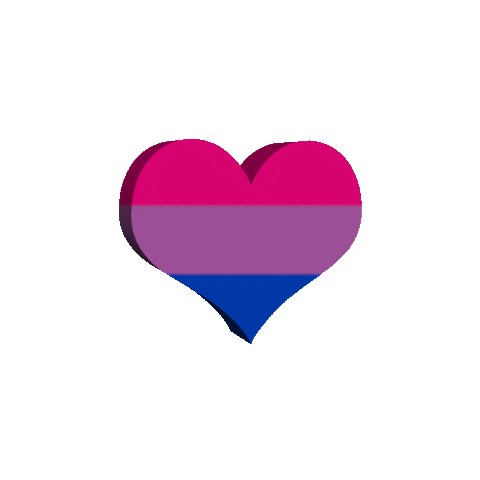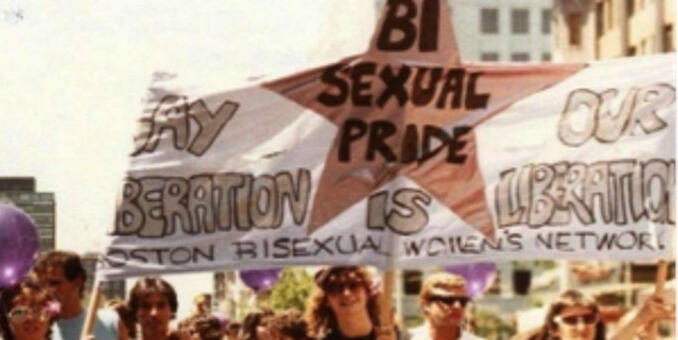bi-the-way.com

BI THE WAY
bi-the-way.com

Bisexuality
Bisexuality is a broad and inclusive term that describes sexual, romantic and/or emotional attraction to those of the same/similar gender and to those of a different gender.
Some Important Points To Note:
People may or may not experience this attraction in differing ways or to differing degrees over their lifetime.
A bi person may or may not have a preference for one gender more than others.
Attraction to both the same and different means attraction to all. Bisexuality is inherently inclusive of everyone, regardless of gender.
Sources:
Bi 101
What is Bisexuality?
Understanding Bisexuality
Bisexual FAQ
Bisexual Definition | LGBTQ Center
Bisexual Identity
A Quick Guide to Understanding Bisexuality
The “Bi” in Bisexuality Doesn’t Mean Two Genders
Defining Bisexuality Masterdoc
bi-the-way.com

The Bisexual Manifesto
The Bisexual Manifesto was written in 1990 and was included in an issue of Anything That Moves, a bi magazine created by the Bay Area Bisexual Network. A full transcription, including background info can be found here
"We are tired of being analyzed, defined, and represented by people other than ourselves—or worst yet, not considered at all. We are frustrated by the imposed isolation and invisibility that comes from being told or expected to choose either a homosexual or heterosexual identity. Monosexuality is a heterosexist dictate used to oppress homosexuals and to negate the validity of bisexuality.
Bisexuality is a whole, fluid identity. Do not assume that bisexuality is binary or duogamous in nature; that we must have "two" sides or that we MUST be involved simultaneously with both genders to be fulfilled human beings. In fact, don't assume that there are only two genders. Do not mistake our fluidity for confusion, irresponsibility, or an inability to commit. Do not equate promiscuity, infidelity, or unsafe sexual behavior with bisexuality. Those are human traits that cross ALL sexual orientations. Nothing should be assumed about anyone's sexuality—including your own.
We are angered by those who refuse to accept our existence; our issues; our contributions; our alliances; our voice. It is time for the bisexual voice to be heard. Do not expect each magazine to be representative of all bisexuals, for our diversity is too vast. Do not expect a clear-cut definition of bisexuality to jump out from the pages.
We bisexuals tend to define bisexuality in ways that are unique to our own individuality. There are as many definitions of bisexuality as there are bisexuals. Many of us choose not to label ourselves anything at all and find the word 'bisexual' to be inadequate and too limiting. Do not assume that the opinions expressed are shared by all bisexuals, by those actively involved in the Bisexual Movement, by the ATM staff, or the BABN Board of Directors."
bi-the-way.com

The Bisexual Umbrella
An umbrella term is a word or phrase covering a broad range of related things that are different from each other but all belong to the same category. Bisexuality is an umbrella term encompassing a wide range of identities, labels, terms and attractions that all fit the scientific definition of bisexuality.
Just as there are millions of ways to be straight, gay, lesbian, or asexual, there are as many ways to be bi as there are bi people. No one word can fully capture the nuances of personality, culture, beliefs, or personal preference; no word should try to. The term bisexuality makes no such pretense— it is a general and inclusive term that encompasses everyone; all sexes and all genders. That does not mean that bi people are attracted to everyone, simply that bi people’s attractions aren’t limited by sex or gender.
Some people under the bi umbrella use different labels to describe their sexual orientation, such as polysexual (attraction to multiple genders, but not all), pansexual (attraction to those of any or all genders; attraction regardless of gender) and omnisexual (attraction to those of all genders, with gender playing a role in that attraction).
Some people prefer the term fluid meaning that attractions do not fit into any neat category, and may shift while including people of more than one gender over time. These labels can be used by themselves or as additional descriptors. Some people feel that their sexuality, while not limited by sex or gender, is best left unlabeled because it is not central to their sense of self.
If these terms all seem to mean the same thing, that is because they basically do! Still, these words have value in that they allow people to describe their sexuality in ways that feel more comfortable or precise. They allow people to express their identity; how they see and understand themselves and want to be seen by others.
It’s helpful to note that although anyone who experiences both homosexual (same-gender) and heterosexual (different-gender) attractions is bisexual according to the scientific definition, that does not mean that they will label themselves or even think of themselves (identify) as bi.
Some people benefit from using these labels instead of bisexuality, but others do not. These labels exist to describe specific experiences that a bi person may experience, but that does not mean that everyone wants to use them or even feels comfortable using them.
Bisexuality is broad and encompasses many different experiences. There is no one clear-cut definition of bisexuality, as it is often personally defined in ways unique to one’s own individuality. Telling a bisexual person they're actually another label because of how they experience their sexuality erases the inherent fluidity of bisexuality and the diversity of the bi community.
While labels like pan, omni, and poly may sometimes be included in bisexuality and may be used synonymously with bisexual, this does not mean pan/omni/poly people have to consider themselves bi or identify as such and vice versa with bisexuals and labels like pan/omni/poly.
It is ultimately up to the individual to decide what they feel most comfortable identifying as or which label they connect to the most, and that can be bisexual, any other label. Some people even identify with multiple labels and use them interchangeably.
Bi+ Community: An encompassing term for people with the capacity to be attracted to multiple genders and sexes. The bi+ community includes anyone who identifies as bisexual, pansexual, omnisexual, polysexual, fluid, queer, other labels or even unlabeled. This may also be referred to as m-spec (short for multisexual spectrum).
Sources:
Bi.org
Bi Resource Center
Personal and Political Labels
What Does “M-spec” Mean?
Under the Bisexual Umbrella: Diversity of Identity and Experience
Human Rights Campaign
The Trevor Project
Definitions of Pansexuality to Avoid
Are Bisexuality and Pansexuality as Different as People Say?
bi-the-way.com
This is a transcription of ‘Bisexual Movement'. This essay, co-authored by Robyn Ochs and Liz Highleyman, appeared in Lesbian Histories and Cultures: An Encyclopedia. Ed. Bonnie Zimmerman, pp. 112-114. (Garland, 2000). It provides a brief history of the US bisexual movement from the 1970s through the 1990s.
Evolution of The Bisexual Movement
The 1970s marked the beginning of the modern bisexual movement. The bi movement of the 1990s consists of social, support and political groups throughout the United States and other parts of the world.
The Early Years
The earliest bisexual organizations in the United States grew out of the sexual liberation movement or “sexual revolution,” which was, in turn, fueled by the women’s liberation movement, the gay liberation movement, and the legalization of, and increased access to, birth control. A number of bisexuals were active in the formation of various chapters of the Sexual Freedom League. The National Bisexual Liberation Group was founded in 1972 in New York City. The Bi Forum, also in New York City, began in 1975. The Bisexual Center in San Francisco, California, formed in 1976, and Bi Ways in Chicago, Illinois, began in 1978.
These years spanned the era of “bisexual chic,” in which popular media publicized the bisexuality of rock stars and artists. The earliest bisexual groups were primarily social in focus, although some included a political element as well. The 1970s also saw the publications of several books about bisexuality. Janet Bode’s View From Another Closet (1976) was perhaps the first, followed [among others] by Charlotte Wolf’s Bisexuality: A Study (1977), and Fritz Klein’s The Bisexual Option: A Concept of One Hundred Percent Intimacy (1978).
The Second Wave
Many bisexuals were active within the gay liberation, and later the lesbian and gay, movement. However, several factors, including an increased focus on identity politics and hostility and rejection by some lesbians and gay men, led some bisexuals to create separate bisexual organizations.
The “second wave” of bisexual organizing, beginning in the early 1980s, was largely women led, and was strongly influenced by feminism. Many of the women involved in bisexual organizing in the 1980s had been, and were still, active in the gay, lesbian feminist, and women’s movements. Feminist bisexual women’s organizations were formed in Boston, Massachusetts (1983); Chicago (1984); New York City (1983); and Seattle, Washington (1986). While in the 1970s most groups were of mixed gender, in the 1980s a number of women-only bi groups and a smaller number of bisexual men’s groups formed.
The bisexual groups of the 1980s focused on providing support and social opportunities, and a number became increasingly involved in political organizing as well, especially in the wake of the AIDS epidemic in the early 1980s. The number of bi groups continued to grow throughout the 1980s in the United States, the United Kingdom, the Netherlands, Germany, Scandinavia, Canada, Australia and New Zealand. The mid-1980s saw the first bisexual groups devoted to political activism (San Francisco’s BiPol, and Boston’s Bisexual Committee Engaging in Politics [BiCEP], and the first regional bisexual networks (the East Coast Bisexual Network and the Bay Area Bisexual Network).
While some bisexuals focused on the creation of organizations for and by bisexual people, others were organizing within lesbian and gay communities. A major focus of the bi movement in the 1980s was to seek inclusion and recognition for bisexuals within lesbian and gay groups. Some formerly “lesbian and gay” organizations changed their titles or their statements of purpose to include bisexual people, while others chose not to. This was especially evident on college campuses, as many campus groups, which had in the 1970s had changed their names to add “lesbian,” did the same in the 1980s with “bisexual” (and increasingly in the 1990s, with”transgender”). In some areas of the country, inter-community relationships, particularly between some lesbians and bisexual women, remained tense; in other areas, bisexuals were more readily welcomed.
Bis Organize More Widely
In June 1990, San Francisco’s BiPol organized the first national conference on bisexuality, with a focus on consolidating a nationwide bi organization, then known as the North American Multicultural Bisexual Network. In 1991, at a meeting in Seattle, the organization was renamed BiNet (Bisexual Network of the USA). The second U.S. national conference took place in 1993 in conjunction with the March on Washington for Lesbian, Gay and Bi Equal Rights and Liberation, the first national march to mention bisexuals by name.
The first U.S. regional conference on bisexuality was held in Hartford, Connecticut, in 1984. By the early 1990s, there were regional conferences taking place annually in the Northwest, the Southwest, Southern California, the Midwest, and the Northeast. The first International Conference on Bisexuality was held in Amsterdam in 1991. Other international conferences have been held in London (1992), New York City (1994), and Berlin (1996), and Boston (1998).
Bisexuality in Literature and Academia
The 1990s saw an increase in the participation of college students in the bi movement and greater bisexual visibility in literature and academia. There was another wave of books about bisexuality, this time including anthologies that focused on personal experiences, such as the influential Bi Any Other Name: Bisexual People Speak Out (1990).
The record-setting year was 1995, which saw the publication of numerous studies and anthologies by both mainstream and alternative presses, including the Bisexual Resource Guide (Bisexual Resource Center). The first national bisexual magazine, Anything that Moves: Beyond the Myths of Bisexuality, had begun publication in 1991. Computer newsgroups, electronic mailing lists and chat lines helped connect bisexuals across geographic lines. The first college course focusing on bisexuality was taught at the University of California at Berkeley in 1990, followed by a course the next year at the Massachusetts Institute of Technology, and several more in subsequent years at Tufts University.
Conclusion
Not unlike lesbian and gay organizations, bisexual organizations have developed in a number of different directions. Some bisexual people focus on organizing for, and with, other bisexual people. Others focus on working within “lesbian and gay,” “lesbian, gay and bisexual,” “lesbian, gay, bisexual, and transgender,” or “queer” organizations to educate heterosexuals, fight homophobia, advocate for civil rights legislation, and build community. Still others are interested in creating a broad sex and gender liberation movement that is not as focused on identity politics. And like many lesbians and gay men, many bisexual people are not involved in any organizations or movements at all, choosing instead to focus their energies on their individual lives.
Bibliography
Bisexual Anthology Collective, ed. Plural Desires: Writing Bisexual Women’s Realities. Toronto: Sister Visiohn, 1995.
Hutchins, Loraine and Lani Ka’ahumanu, eds. Bi Any Other Name: Bisexuals Speak Out. Boston: Alyson, 1990.
Off Pink Collective, Bisexual Lives. London: Off Pink Publishing, 1988.
Rose, Sharon, et al., eds. Bisexual Horizons: Politics, Histories, Lives. London: Lawrence and Wishart, 1996.
Tucker, Naomi, ed. Bisexual Politics: Theories, Queries, & Visions. Binghamton, NY: Haworth, 1995.
Learn More About Bi History:
In-Depth History of Bisexuality
Bisexual U.S History Chronology
Bisexual Movements
Bisexual Activism
The Bisexual Warriors of the “Gay” Movement
LGBTQ Heritage | Making Bisexuals Visible
History of Bisexuality As An Orientation
Bisexuality In The Han Dynasty
Bi+ History
Bisexuality: A Critical Reader
bi-the-way.com

Bisexuals to Know
Activists
Brenda Howard
Lani Ka’ahumanu
A. Billy Jones Hennin
Dr. Ibrahim Farajaje
Donny The Punk
Michael Strange
Malcolm X
Emiliano Zapata
Writers
June Jordan
Alice Dunbar Nelson
Loraine Hutchins
William Shakespeare
Walt Whitman
Virginia Woolf
Anaïs Nin
Colette
Jane Bowles
Edna St. Vincent Millay
Ana Castillo
Florence Virginia King
Kate Millet
Alice Walker
Rebecca Walker
Roxane Gay
Liz Highleyman
Robyn Ochs
Juana María Rodríguez
Julia Serano
Musicians and Entertainers
Nina Simone
Sister Rosetta Tharpe
Josephine Baker
Billie Holiday
Bessie Smith
Ma Rainey
Ethel Waters
Marilyn Monroe
Whitney Houston
Grace Jones
Freddie Mercury
James Dean
Katharine Hepburn
Sir Alec Guinness
Cary Grant
Joan Baez
Brenda Fassie
Janet Gaynor
Greta Garbo
Tallulah Bankhead
Leslie Hutchinson
Emile Griffith
Artists
Frida Kahlo
Jean-Michel Basquiat
Amrita Sher-Gil
Marie Laurencin
Historical Figures
Julie d'Aubigny
Eleanor Roosevelt
Alexander The Great
Alfred Kinsey
Fritz Klein
bi-the-way.com